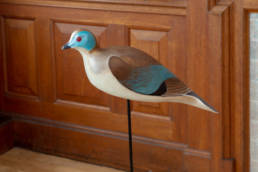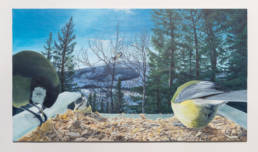Scott Rogers
Decoy, 2015
Painted Wood
Codec, 2019
Acrylic on board
Scott Rogers’ (b.1981) work addresses how humans understand their interactions with – and treatment of – the natural world, and questions the institutions to which people and nature are made to adhere. It is rooted in the observation that many devices used by scientists or conservationists to monitor animal populations were originally designed as traps for the purposes of hunting.
Decoy (2015) is a hand-carved sculpture based on passenger pigeon decoys used by European settlers in nineteenth-century North America. The passenger pigeon population was in the billions when Europeans arrived, but it was made extinct by industrialised hunting and the destruction of its habitat. Decoys would be judiciously placed to attract thousands of birds, which would then be shot to feed pioneers at the frontier and slaves on plantations. Rogers often references the vernacular aesthetics of communities or individuals who make objects for purposes other than art, but which are then drawn into the art market and labelled as ‘amateur’ or ‘outsider’. Handcrafted decoys from the era command high prices at auction and Rogers’ version is based on those that have recently appeared in sales catalogues.
Codec (2019) depicts a forest in Norway, which – despite appearing picturesque – is a monocultural conifer plantation, where animal life is sparse due to limited food. Rogers repurposed a discarded perspex museum display as a bird feeder, and installed a camera to monitor its use. He noticed that the only birds using the feeder were breeds that had adapted to accept human charity, rather than the more diverse creatures found in natural forests. Rogers copied a still from the feeder video using skills he’d been taught by a wildlife painter, a way of painting he describes as ‘deceptive’, as it seems to signal virtuosity but is actually more like ‘the execution of a programme.’ Despite this, he considers the work optimistic due to the level of attention it required, and because it embodies ‘hunting without killing.’
Exhibited in:
Untitled
The Tetley, Leeds (24 Sept 2019 → 19 Jan 2020)

